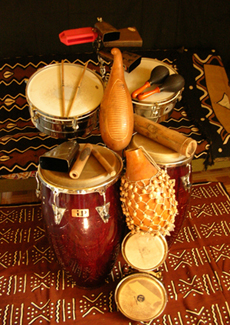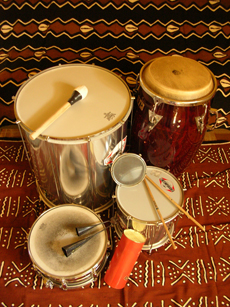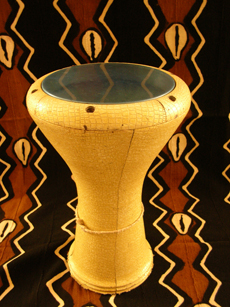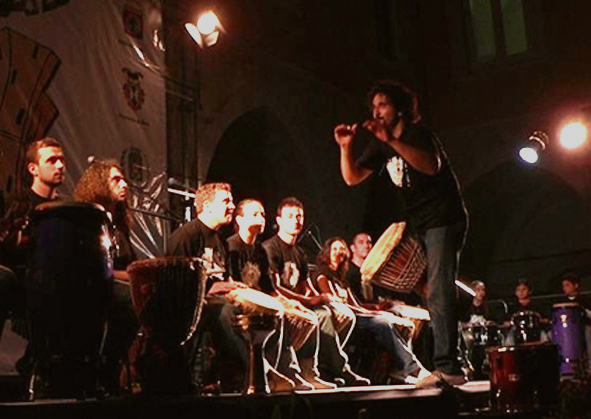Afro-Cuban percussion course
congas, bongò, timbales, batà, clave, cowbell, guiro, maracas, shekeré
- history of Afro-Cuban culture
- concept of clave
- basic technique: hand setting, sounds and rudiments on the conga drum
- Tumbao rhythm on one and more congas
- congas rhythms: Sòn, Danzòn, Cha Cha, Charanga, Guaracha,
Bolero, Sòn-Montuno, Guaracha, Dengue, Pilòn,
Piccadillo, various ----- types of Songò,
Jazz conga patterns, Reggae conga patterns, Descarga, Afro-Cuban rhythm, Bomba-portoricana,
Cuban Bomba.
- percussions in the Cuban rhythmic orchestra: bongò and cowbell, timbales, clave, guiro, maracas
- rumba from Havana, Matanzas and Santiago de Cuba
- variations of salidor and segundo drums in the rumba
- solo patterns of the quinto drum in the rumba
- yoruba, bantù, abakuà and ararà ritual traditions
- Cuban Carnival rhythms: Conga from Havana and Santiago
Brazilian percussion course
surdo, repinique, atabaque, agogò, tamborim, caixa, ganzà, cuica, chocalho
- history of samba and Afro-Brazilian culture
- samba enredo, samba pagode, samba funky, samba reggae, maracatù,
ijexà, baiao, congado and galoppe rhythms
- variations of the surdo centrador drum in the samba
- typical patterns of the bateria de samba


Darbouka course
- basic hand settings and sounds
- Maqsum and Malfuf rhythms
- rudiments for the development of roll
- solo variations and patterns
- Zegaïri, Hella I, Hadaoui, Oranais, Aâlaoui II, Touareg, Gioby,
Tbila, Masmoudi, Kashlima, Chiftitelli, Gawazi, Karachi, -
Samai, Saadi and Algerian rhythms.
Afro-American
Percussions is a workshop of ethnic percussions addressed to people aged
16 years and over, interested in experiment a collective and practical experience
with rhythm.
The main goal is to develop a music ensemble, achievable through
communication and listening to the other through the rhythm.
The workshop is structured through group meetings where participants play
different kinds of percussion instruments, belonging to the Cuban,
Brazilian, West African and Arabic rhythmic culture,
learning to get closer to the musical traditions of these populations.
Instruments are played by hands, to experience the direct contact
with the drum skin and vibrations, or by wooden and metal sticks.
The role of the conductor is that of guide, which serves as a point
of reference for the group, in order to understand and make realizable the
execution of rhythms, bring out and enhance the innate musical-rhythmic ability.
Listening to others, collaboration and communication
are the foundation of the workshop, where the sharing and exchange of emotions
reinforce the relationship between the participants.
Everyone contributes to the group with his own rhythmic experience that is
able to offer, feeling the pleasure of sharing it with others and making it
available to achieve a common goal: to play rhythms of Afro-Latin American
traditions.
During the course of the workshop, participants are also invited to experience
moments of collective improvisation, or creative space within which
can play instinctively, drifting totally emotions.
The workshop aims to provide progressively to the group the ability to perform
a polyrhythm, with which eventually becomes possible to realize a
performance at the end of the activity.
main
targets:
- learning to listen and communicate with others
- stimulate creativity
- develop the sense of community and cooperation
- accustom to make its own contribution to a group
- knowing cultural traditions of other populations
- develop the sense of music and rhythm through the research of sounds
and beats in harmony with their own personality.
- obtain benefits in health: reducing stress and emotional release
- carry out a performance at the end of the workshop
program:
-
direct contact with percussion instruments
- playing simple rhythmic patterns
- creation of an ensemble
- improvisation
instruments:
- bass, medium
and high pitched drums (congas, djembé, darbouka), floor toms, snare
drum, cymbals, cowbells, woodblocks, - triangles,
clave, shakers, bells, rattles, recovered items, wooden and metal sticks.





Drum Circle
The
facilitated Drum
Circle is an unique event, to which all those who want to
experience a state of wellbeing can participate, having fun with music and
rhythm. It can take place everywhere, both outdoors and indoors.
It is not necessary to be percussionists or musicians, but to want to play
percussion freely and spontaneously in a circle, invited and supported by
the facilitator, who helps the group to discover the pleasure of
being an integral part of a pulsating organism, in which everyone communicates
with the others and creates musical harmony.
To a Drum Circle can participate people of all ages, children, adolescents,
adults, seniors, musicians, percussionists, singers and beginners.
In this lies the great communicative and unifying force of experience, during
which everyone contributes his own rhythmic sense, expressing and discovering
his own innate musicality.
It is not a percussion workshop in which you learn to play, but an intense
experience of sharing that takes place in a single time, with a duration varying
from about 1h10' to 1h30', possibly repeatable with regular or occasional
frequency, forming every time groups with the same participants or with new
people.
Learning occurs in an indirect and natural way, through techniques that the
facilitator puts in place and that fall within the method of "teaching
without teaching" devised by Arthur Hull, founder of the
Village Music Circles that has spread the practice of the Drum
Circle throughout the world. This method gradually makes the group aware
of the different sounds and types of instruments, the expressive dynamics
of music and the spontaneous melodies that can be created in the collective
rhythm.
The Village Music Circles method is accredited by the MIUR - Ministry
of Education, University and Research for its contents of education in listening,
dialogue, collaboration and harmony.
Who has his own drum can take it with him, whoever does not have one, finds
it on the place along with many other small percussions made available by
the facilitator.
Just choose an instrument and relax, letting yourself be guided by the collective
rhythm and the enveloping energy of the drum circle.

